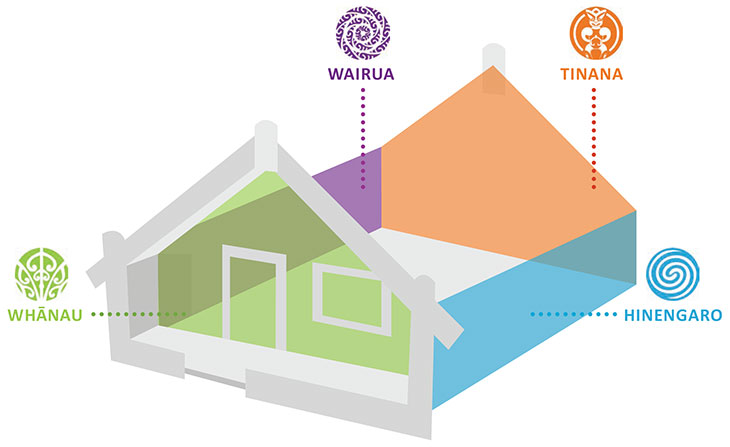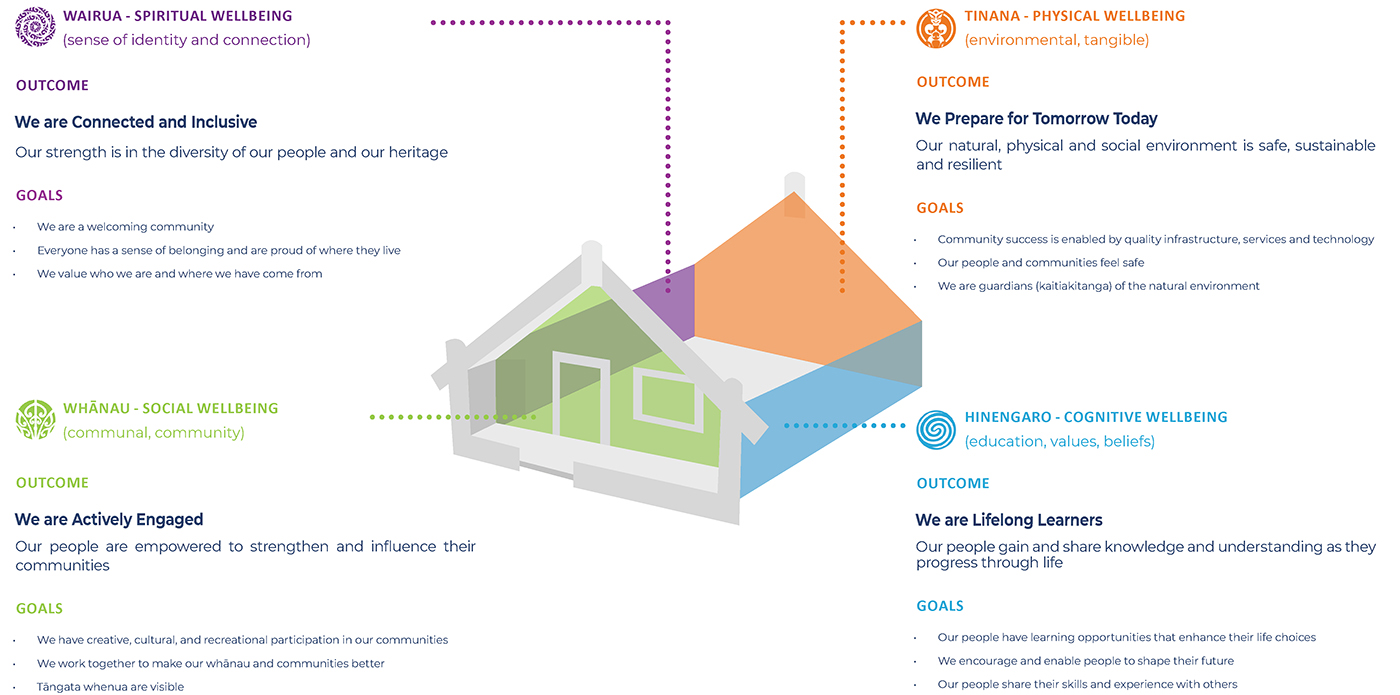Community Development Strategy
Download the Community Development Strategy (PDF file, 2.7 MB) document.
Welcome
Tērā te karanga o te iwi, “Tēnā huakina ngā tatau o te whare kia tae ai taku tiro ki ngā taonga ā-roto”. Ko te whakahoki o te kaunihera ā-rohe o Manawatū, ko tēnei, “Kua tuwherahia ngā tatau ki a koutou katoa. Tomo mai ki tō tātou nei whare kia āhuru ai te noho. Nau piki mai, haere kake mai!”
The people call saying, “Open the doors of the house that I may see the gifts within”. Manawatū District Council responds, “The doors are open to you all. Enter into our house that your stay may be comfortable. Welcome and come on in!”
Community development is about everyone working together to make our communities a fantastic place to grow up, grow old and everything in between.
Community development is about whanaungatanga (relationships). Shared experiences and working together creates a sense of belonging.
Whanaungatanga happens when we work together to:
- Celebrate our diversity
- Welcome newcomers
- Learn and share our knowledge with others
- Ensure the environment in which we live is safe, strong and healthy both now and in the future
- Build strong, resilient, sustainable local communities
- Strengthen the interests and values of our District’s residents by encouraging active participation
- Generate community led opportunities and outcomes
- See ourselves as a single, cohesive community as well as a collection of smaller communities based on our geographical location or on areas of special interest or identity
Manawatū District Council Community Development Strategy Vision:
Our District offers a high quality of life for all residents
While there is a lot MDC can do directly to achieve this vision, a critical role of Council is to partner with our community, supporting grassroots initiatives in a variety of ways. There are many groups in our community who strive for the social, cultural, physical and spiritual wellbeing of individuals and families. The whakawhanaungatanga groups demonstrate building relationships through shared experiences and working together is essential to community wellbeing and Council honours the critical work they do.
Another role of Council is to advocate to Central Government on issues that impact on the wellbeing of our communities but are outside Council control. Council is committed to working for, with, and on behalf of the Manawatū community – and the individual communities that make up our District - to ensure that our District offers a high quality of life for all residents.
This Community Development Strategy is one of several strategic documents which contribute to Council’s vision. Appendix 3 shows how these strategies and plans work together towards Councils vision of a:
Connected, vibrant and thriving Manawatū District - the best lifestyle in New Zealand
Who Are We?
The Manawatū District has a diverse population ranging in age, ethnicity, health, choice of where they live, income, education and more. This infographic (PDF file, 178.1 KB) shows how the district is made up and compares to the rest of New Zealand. This information is updated regularly as the statistics are released.
Te Whare Tapa Whā

Te Whare Tapa Whā can be literally translated as ‘the four-sided house’
Te Whare Tapa Whā is a model of health which was developed in 1982 by Mason H. Durie (Ngati Kauwhata). It encourages us to employ a more holistic way of viewing health and wellbeing by using four key perspectives or dimensions:
- Te taha wairua (spiritual wellbeing)
- Te taha whānau (social wellbeing)
- Te taha tinana (physical wellbeing)
- Te taha hinengaro (mental wellbeing)
Additionally, the Te Whare Tapa Whā model can help illustrate how each dimension affects the others. Te Whare Tapa Whā invites us to consider more holistic solutions and remedies. A house needs all four walls in order to be strong.
The Importance of the Wharenui in the Te Whare Tapa Whā model
The marae is a place that brings people and communities together, helping to support, care for, and protect the people and manuwhiri (visitors).
At the centre of it all, you will find what is known as the wharenui (main meeting house). From a Māori world perspective, the house is viewed as an ancestor and reflects the physical traits of a person e.g. maihi (arms), raparapa (hands), and tāhūhū (spine). Given that Māori view the wharenui in this manner, it holds even greater significance to its people as the most senior elder on the marae, and is fiercely protected, especially during times of pōwhiri (ceremonial welcome). The people protect the wharenui and all taonga (treasures) held within, including women and children.
Community Development Strategy
Te Whare Tapa Whā model is primarily used to help view wellbeing in a holistic manner, however, this model of health can also be adopted to explore potential, opportunity and consequences in all aspects of life.
Council has used the Te Whare Tapa Whā model to explore the wellbeing of the Manawatū District, and how we might contribute to its wellbeing in a more holistic manner. The model forms the framework for this Community Development Strategy.
Where Are We Headed?
Our District offers a high quality of life for all residents
Where Are We Now?
Council already supports our community in a variety of ways. We provide funding, support and encouragement to community groups and individuals who contribute to the community outcomes
 WAIRUA - SPIRITUAL WELLBEING
WAIRUA - SPIRITUAL WELLBEING
Council...
- supports organisations that protect and promote the heritage, identity and social wellbeing of the District
- actively promotes Māori culture in the community
- increases staff capability to work in multicultural environments
- supports the care and maintenance of urupā and private cemeteries
- invites a representative of the Manawatū Christian Leaders' Network to open Council meetings in prayer
 WHĀNAU - SOCIAL WELLBEING
WHĀNAU - SOCIAL WELLBEING
Council...
- supports the promotion of, and participation in, sport and active recreation
- hosts the annual MDC Community Honours Awards
- enables community representation and participation through Community Committees
- liaises with the community through community-focussed Council positions
- supports community facilities for community activities and events
- is developing a Walking and Cycling Strategy
 TINANA - PHYSICAL, ENVIRONMENTAL
TINANA - PHYSICAL, ENVIRONMENTAL
Council...
- supports organisations that enhance the wellbeing of the natural, physical and social environment
- supports community initiatives that protect, beautify and communicate the value of our natural land, water and coastal environments
- ensures the planning and design of our public spaces caters for all - including those with additional needs
- actively engages in environmental protection groups and agreements
- invests in careful planning, education and preparation for disaster resilience
- ensures the District Plan reflects urban design principles including crime prevention through environment design (CPTED)
- ensures land use planning is a collaborative process between Council, Iwi and the wider community
- supports the development and review of Community Plans and encourages, and partially funds, their implementation
- is developing a Community Facilities Strategy
- works with a range of key experts to provide non-financial support and advocacy for those affected by Earthquake Prone Building legislation
 HINENGARO - COGNITIVE WELLBEING, EDUCATION, VALUES, BELIEFS
HINENGARO - COGNITIVE WELLBEING, EDUCATION, VALUES, BELIEFS
Council...
- maintains active participation in the Mayor’s Taskforce for Jobs (NZ)
- supports career pathways for youth in the District
- Council-controlled organisations
- Central Government Agencies
- Community organisations (volunteer and faith-based organisations)
- Neighbouring local authorities
- Iwi, Hapū, Whānau and Māori communities
- Service clubs
Actions For 2021-2023
As well as the things Council already does, between January 2020 and 1 July 2021 Council will do the following things to further encourage a strong, happy and resilient community. See the full list of actions and measures (PDF file, 93.4 KB).
 WAIRUA - SPIRITUAL WELLBEING
WAIRUA - SPIRITUAL WELLBEING
- Articulate a clear statement on the use of Te Reo Māori in Council communal spaces
- Encourage opportunities for expressing the cultural diversity in our District
- Implement a local action plan for seniors that links to the national Better Later Life Strategy
- Implement a local action plan for youth that links to national strategies
- Support works of art and sculpture in public spaces across the District
- Actively participate in the Manawatū Health and Wellbeing Group
- Increase partnership potential with the faith communities in the District by developing a register of faith organisations, their places of worship, and their social and community work
- Strengthen Council’s relationship with the faith communities in the District by further understanding and recognising the work they do in the community
 TINANA - PHYSICAL, ENVIRONMENTAL
TINANA - PHYSICAL, ENVIRONMENTAL
- Enable those of other cultures and languages to participate in the community
- Facilitate Māori contribution and participation in Council decision-making
- Formalise Manawatū Youth Ambassadors as a Community of Interest within the Community Committee Policy
- Support community initiatives that seek to overcome social isolation
- Work with Manawatū Community Trust to develop a 30-year approach to the provision of social housing
 WHĀNAU - SOCIAL WELLBEING
WHĀNAU - SOCIAL WELLBEING
- Investigate and develop an Environmental Sustainability Strategy
- Pursue opportunities for funding from Central Government for initiatives related to environmental responsibility
- Complete the review of the Rural and Residential Zones in collaboration with Council, Iwi and the wider community
- Adopt and implement a Walking and Cycling Strategy
- Adopt and implement a Community Facilities Strategy
- Participate in new opportunities for engagement with environmental groups and agreements
- Investigate options for the provision of financial and further non-financial support for the preservation of the heritage character of Feilding and the District
 HINENGARO - COGNITIVE WELLBEING, EDUCATION, VALUES, BELIEFS
HINENGARO - COGNITIVE WELLBEING, EDUCATION, VALUES, BELIEFS
- Actively support volunteering in our community
- Review community information services in order to improve the effectiveness of distribution
- Invest in community development sector governance capability
- Ensure diverse and capable representation on Council controlled governance structures
- Support home-based learning and small business professional development
Long term actions
Actions for July 2021 forward
![]() Adopt and implement an environmental sustainability strategy
Adopt and implement an environmental sustainability strategy
![]() Partner with Manawatū Community Trust to implement their 30 year approach to the provision of social housing
Partner with Manawatū Community Trust to implement their 30 year approach to the provision of social housing
![]() Implement Council’s Community Facilities Strategy
Implement Council’s Community Facilities Strategy
![]() Implement Council’s Walking and Cycling Strategy
Implement Council’s Walking and Cycling Strategy
Council As Advocate
One of Council's roles is to advocate to Central Government on issues that impact on the wellbeing of our communities but are not within Council's control.
Council advocates for:
 WAIRUA - SPIRITUAL WELLBEING
WAIRUA - SPIRITUAL WELLBEING
- Holistic focus and equitable access for all in the health and wellbeing sector
 WHĀNAU - SOCIAL WELLBEING
WHĀNAU - SOCIAL WELLBEING
- Increased citizen engagement with Central and Local Government elections
 TINANA - PHYSICAL, ENVIRONMENTAL
TINANA - PHYSICAL, ENVIRONMENTAL
- Improved district-wide public transport services
- Cell phone and internet connectivity in rural blackspot areas
- Adequate power supply for our growth areas
- Adequate policing resources for our communities
- Availability and affordability of community and social housing
- Removing the barriers to the provision of community and social housing
 HINENGARO - COGNITIVE WELLBEING, EDUCATION, VALUES, BELIEFS
HINENGARO - COGNITIVE WELLBEING, EDUCATION, VALUES, BELIEFS
- The promotion of employment opportunities for young people
Appendices
Appendix 1 | How did this strategy come about? - PDF file (114.6 KB)
Appendix 2 | Full table of Actions and Measures - PDF file (93.4 KB)
Appendix 3 | Related Council Strategies and Documents - PDF file (139.1 KB)
Appendix 4 | Meaning of symbols and colours used in this strategy - PDF file (207.8 KB)
Infographic | Who are we - PDF file (178.1 KB)
Infographic | How are we doing - PDF file (49.4 KB)

